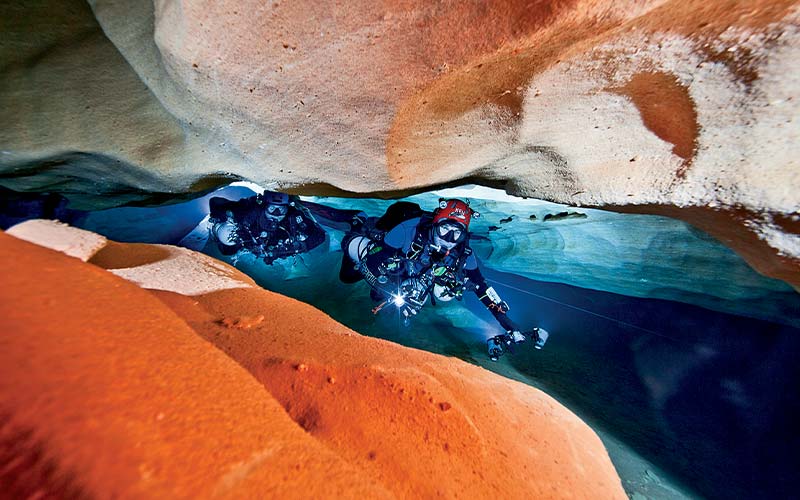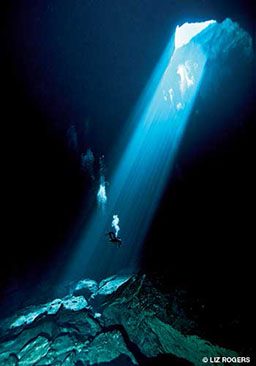Why Dive in Caves?
Cavern and cave diving are activities not every diver would enjoy. A cavern is generally defined as the first part of a cave, when you can turn around and still see the exit. The cave starts when you swim around a bend, and you cannot see daylight in any direction. In this article I’ll refer to both types of diving as “cave diving,” because cavern diving is where it all begins for those of us drawn down into the earth — to places so few people will ever see.
To fin along a path less trodden is part of the attraction, but there are many other reasons divers explore caves. With no sunlight to sustain bacteria and no water movement to hold silt in suspension, visibility can reach astonishing distances — up to 200 feet in some caves. In an enormous chamber, divers may be able to see another tiny pair of divers and their lights all the way over on the other side, the water so clear it is literally invisible — like floating in space.

Some caves actually look like the surface of the moon, with pale white limestone carved into strange, unearthly shapes. In other caves the water moves along rapidly, and divers swim against the flow going into the cave and, if the passages are large enough, fly along with the flow heading out. Dives like these are truly remarkable experiences. On the other side of the coin, sometimes the water flows inward from the entrance, and divers need to be extra cautious to turn around with enough remaining gas to swim against the flow and still make it out with gas in reserve for safety.
To the trained eye, caves offer as much variety as exists between different shipwrecks or different reefs. Some caves have white walls, some dark walls that eat your torchlight, and some have stripes from alternating seasons that either send dark water into the cave or clean water to flush it out. Because they are most commonly made of limestone, many caves have beautiful fossils embedded in the walls.
Strange animals live in caves. Having adapted to the cave environment over eons, they may lack pigmentation and appear pale white; many are blind with extra-long feelers to detect food in the complete dark.
In the same way ocean divers often develop a store of knowledge over time, so too do cave divers, and conversations leading up to and following dives are as animated as those on any dive boat. In short, cave diving offers an opportunity to visit unique environments with adventure aplenty and as part of a dive group that shares a passion.
How to Start Cave Diving
The path from recreational diver to cave diver is now clearly marked. First, we start in caverns and learn the basics of safe cave diving. These include the five golden rules, which cover gas planning, maximum depth, adequate lighting, marking the trail and the need for training. New skills introduced at this time include finning techniques such as the frog kick. This kick can minimize the risk of stirring up silt, which could disorient divers and cause them to lose their way.

After the cavern diver course, we usually go dive caverns as much as we can until we start shining our torches around the bend and thinking, “I wonder what’s down that passage.” The next level of training is usually an intermediate phase in which divers start diving with more than one cylinder and practice running line. Several types of reels are available today, and divers should learn to use the ones they will be using after the course. Some caves have a “gold line” from the entrance through the main passage; some require the lead diver to lay line beginning some distance beyond the entrance to prevent curious novices from following the gold line into the cave. This training level usually comes with some restrictions so we don’t go too fast too soon: “no leaving the main line to explore side passages” or a gas restriction such as “no diving beyond a third of a pair of doubles,” for example. Different training agencies have different restrictions, but they are all intended to encourage new cave divers to gain experience before moving even farther into the earth.
After making a number of cave dives, which seem incredibly adventurous, you’ll be ready for a course to become a “full-cave diver.” This level of training includes learning to dive complex caves, running short lines (called “jumps”) and using line markers such as arrows and “cookies” to record information such as who is still in the cave and which is the shortest way out. Each level of diving increases the amount of potential anxiety divers may experience, so they should gradually add to their experience before progressing. There are a few other pathways to cave diver (in the U.K., for example, divers serve an apprenticeship), but the principles listed here hold firm regardless of the agency by which a diver is trained.
Improved Safety
Sadly, in the early days of cave diving, fatalities were significantly more common than they are thought to be today. Research at DAN examined more than 300 American cave-diving fatalities over a 40-year period and found that modern approaches to cave-diver training, probably coupled with more regulated access, appear to have stemmed the tide of young, untrained and ill-equipped divers drowning in caves. Today it would be difficult to find a recreational diver who does not know you need special training to safely dive in caves.

With that training comes the expectation of suitable gear, and such gear usually costs a bit more than the equipment used for ocean diving. Many of us have been diving for years before we get into the darker side of diving, as cave diving is affectionately known. Considering the experience, the cost of the gear and the expense of the additional training, today’s cave diver may be a few years more seasoned and a bit more cautious. In general, we also have high-quality, well-maintained gear and, above all, advanced training.
One of the added benefits of getting trained as a cave diver is that the skills developed along the way carry over into the rest of our diving. Many of us change the way we fin even when diving reefs so we don’t throw pressure waves down onto the wildlife. We feel more comfortable carrying an extra cylinder and regulator when making deeper dives, and our gas consumption tends to drop as we improve our trim and buoyancy control. This means we use less gas on average, so our dives become less physiologically demanding.
Cave-Diving Travel
The main benefit of all this training, though, is that you get to dive caves. Florida is known in the U.S. as “cave country,” and there is something for everyone there. Deep caves, fast-flowing passages, dark rooms, white rooms, narrow bits to negotiate and tunnels three divers can swim through side by side. Although each region’s caves influence local training courses, most of what you learn during your training is transferable worldwide. I have landed in Poland, Greece and Australia, and after a couple of check-out dives to make sure we’re all using the same signals and procedures, I’ve gone cave diving with the locals. This is a great way to learn even more, including local techniques that might not be taught in your area. No matter how much experience I have, each time I land somewhere new I start at the bottom of the ladder again and arrange for an experienced local to show me the ropes. So far this policy has reaped dividends, not only because I’ve picked up some valuable tips for diving local caves in exotic places, but now I have really good buddies in several countries.

Taking the Plunge
If this sounds like a path you would like to follow, the best advice is to locate a good instructor. Many training agencies offer cavern- and cave-diver certification, and the main differences in quality often come down to the instructor (as is the case with most dive courses). Post an inquiry on some dive forums, visit websites for the National Association for Cave Diving (NACD), the Cave Diving Section of the National Speleology Society (NSS-CDS) or popular cave-diving websites such as cavediver.net. Before signing up for a course, try to contact someone who was trained by the instructor you’re considering. The value of a patient instructor when you’re heading into a place beyond your wildest dreams cannot be overestimated. Don’t be afraid to let your instructor know if something is beyond your comfort zone. Progress cautiously, gradually gaining experience, and above all, remember: Anyone can call any dive at any time.
Explore More
© Alert Diver — Q3 Summer 2012